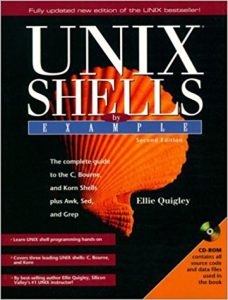
The ‘Unix Shells By Example’ is a well-known book in the field of shellscripting. It has about 640 pages with a CD-ROM included. The book is well edited, with good white-spacing and clarity in layout. Having taught the unix shells for over 15 years, the author really knows her stuff, and the text is factual and to the point.The index seems complete and one doesn’t have a difficulty in finding the right info one is looking for. These properties should be normal for books, but computer books seem often an exception.
The chapters deal about the central unix-commands for scripting (Grep, AWK,SED) and the big three shells (korn, bourne and C-shell). The author explains the subject in great detail by showing examplescripts. First you’re given the data or text to be edited, then the script or commandlines and finally a lenghty line-by-line explanation of the scriptsyntax. The subjects of the scripts range from explaining the basic unix-commands to complex intertwining regular expressions, functions, obscure nawk options etc. The author also touches the subject of shell-history, making comparisons of the three shells, giving ‘lab-exercises’ and some unix background about commandtypes,login and inheritance. The apparent subject that is missing in this book is the Bash shell, the preferred shell in the Linux community. However, a seperate book on this subject is available (Linux Shells By Example). As with all books that have an extensive coverage of the subject, this book too can be overwhelming for the absolute beginners in shellscripting. It takes some time before one writes sytax like:
nawk -F: ‘BEGIN{printf(“What vendor to check?”);\
getline ven <“/dev/tty”};$1 ~ ven\
{print”Found” ven “on record no” NR}’ vendor
Instead of searching the pages for the basics, beginners should consider buying an entrylevel book. Conclusion: For the intermediate scripter who visits shellsites like shelldorado and lurks newsgroups in search of advanced programming constructs to steal this book is a great find. You won’t be left with a feeling that you’ll outgrow this book. For newcomers in scripting this should however not be the first book to buy, they’re better of with titles like “learning shellscripting in 24 hours”. But once through these 24 hours, this book can only be warmly recommended.